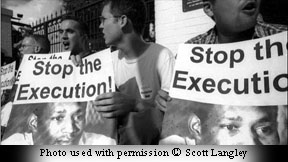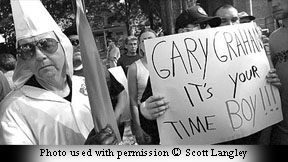The Case of Gary Graham - Post-Trial Period
Appealing the Conviction and Death Sentence
-
roles)) {
// user is not associated with role, redirect to signup page
?>
- Definitions of Key Terms
- The Capital Appeals Process
- Please register or login for free access to our collection of supplementary materials.
Once a defendant has been found guilty, the presumption of innocence is no longer applicable. During any appeal, the defendant has the burden of showing that a critical mistake was made in the process that convicted him.
The Direct Appeal
In Texas, the conviction and sentence of death are subject to automatic review by the Texas Court of Criminal Appeals. Further review may be sought in the Supreme Court of the United States by a procedure called “certiorari.” The U.S Supreme Court has complete discretion to grant or deny certiorari; it need not give any reason for its decision to review or not review a case. The automatic appeal to the Texas Court of Criminal Appeals and any certiorari review of it are collectively called the “direct appeal.”
In the automatic appeal, Graham was represented by a new court-appointed attorney, Doug O’Brien. On June 12, 1984, the Texas Court of Criminal Appeals affirmed Graham’s conviction and sentence. No request for certiorari review was filed.
Subsequent Post-Conviction Proceedings
Then began a lengthy post-conviction process that lasted from 1984 until 2000. Volunteer lawyers for Graham argued that the Texas capital sentencing procedure did not allow the jury to give adequate consideration to mitigating evidence, including Graham’s youth, and that Graham’s trial counsel had been ineffective. Graham contended that trial counsel had failed to investigate, interview and call alibi witnesses and had kept Graham from testifying. Graham further claimed that this ineffective assistance of counsel probaby influenced the outcome of the trial, particularly since there was no physical evidence that tied Graham to the killing of Lambert and there were discrepancies in the eyewitness accounts of the homicide.
Each of these claims was evaluated and rejected by state and federal appellate courts. Despite the judicial refusal to grant Graham relief, the case evolved into one of national interest.
Growth of Public Awareness and Media Presence
-
roles)) {
// user is not associated with role, redirect to signup page
?>
- Houston Chronicle Article Asserting Graham’s Guilt
- Editorial/Opinion Commentary from The Washington Post Regarding Graham
- Please register or login for free access to our collection of supplementary materials.

New evidence casting doubt on Gary Graham’s guilt caught the attention of the public via media stories throughout the United States and around the world. As news of Graham’s case spread, so did public awareness. For many, learning more about Graham’s case heightened already existing concerns about wrongful convictions around the nation and a possible need to take steps to address problems with the death penalty. Thousands of letters in support of granting Graham clemency arrived at the governor’s office; Internet web sites following developments in the case were formed; and death penalty activists organized a month-long series of public actions in protest immediately preceding Graham's execution.
Anti-death penalty advocates, including actor Danny Glover, Reverend Jesse Jackson, Reverend Al Sharpton and Amnesty International’s Bianca Jagger, became involved with Graham’s case in 1993, releasing public statements in support of Graham’s claim of innocence and arguing that the Texas justice system discriminated on the basis of race and class. Protests intensified after the NAACP Legal Defense Fund filed a complaint with the U.S. Department of Justice contending that Graham was on death row as a direct result of widespread racial discrimination within the Texas criminal justice system.
 As Graham’s execution grew closer, protests intensified. Thirty days of protests were held, culminating with a large gathering outside the Texas execution chamber in Huntsville on the execution date. Even Bobby Lambert’s wife wrote to the governor in opposition to Graham’s execution stating: “It has been brought to my attention that there is evidence that creates a possibility of reasonable doubt as to whether or not Gary Graham did, in fact, commit this murder. I do not want the execution of a possibly innocent man on my conscience. I do not believe in capital punishment.”
As Graham’s execution grew closer, protests intensified. Thirty days of protests were held, culminating with a large gathering outside the Texas execution chamber in Huntsville on the execution date. Even Bobby Lambert’s wife wrote to the governor in opposition to Graham’s execution stating: “It has been brought to my attention that there is evidence that creates a possibility of reasonable doubt as to whether or not Gary Graham did, in fact, commit this murder. I do not want the execution of a possibly innocent man on my conscience. I do not believe in capital punishment.”
On the other hand, a large number of people urged the Governor and the parole board to let the execution continue as scheduled. The Houston Chronicle printed articles disparaging Graham’s innocence claims and voicing support for the execution from members of Bobby Lambert’s family as well as victims of Graham’s crime spree in the weeks preceding the homicide. Several of Lambert’s family members, including his sister and children, called for greater emphasis on remembering the victim and the victim’s family members instead of glorifying the killer.
Clemency
-
roles)) {
// user is not associated with role, redirect to signup page
?>
- Graham's Clemency Petition (6.3 MB PDF)
- Attorney General’s Press Release Supporting the Denial of Clemency for Graham
- New York Times Article on George W. Bush and Clemency
- Houston Chronicle Article about Graham’s Clemency Petition and Impending Execution
- Amnesty International’s Report "Killing Without Mercy: Clemency Procedures in Texas"
- Clemency Procedures in Death Penalty States
- Please register or login for free access to our collection of supplementary materials.
Executive clemency is the power of an official or agency in the executive branch of government to nullify a criminal conviction (by granting a "pardon"), to reduce a court-ordered punishment (by granting a "commutation of sentence"), or to delay an execution (by granting a reprieve"). In some States, the Governor alone has these powers; in other States, the powers are given exclusivly to a board of pardons and paroles; in still other States, the powers are divided between the Governor and the board. In Texas, the only form of executive clemency that the Governor is authorized to grant without a favorable recommendation by the Board of Pardons and Paroles is one 30-day reprieve in each capital case. If a majority of the 18-member Board votes in favor of a longer reprieve, a commutation, or a pardon, the Governor may (but needs not) grant it.
Graham’s lawyers petitioned the Texas Board of Pardons and Paroles for clemency twice, in 1993 and in 2000. The Board voted to deny clemency both times. Governor Ann Richards granted Graham a 30-day reprieve in 1993 based on what she said were unanswered questions about the case. Years later, when a new execution date was set, Governor George W. Bush did not have the power to grant a reprieve, although according to his statements he would not have granted a reprieve had he been authorized to do so.
The Execution
-
roles)) {
// user is not associated with role, redirect to signup page
?>
- Texas Department of Criminal Justice Institutional Division Death Row Plan (56 MB PDF)
- "This Man Has Expired: Witness to an Execution" (2 MB)
- Video Tour of North Carolina's Execution Process (Langley Creations Documentaries)
- American Medical Association’s Resolution on Physician Participation in Capital Punishment (108 KB PDF)
- Houston Chronicle "The Graham Execution:Key Witness Asks God to Save Killer's Soul"
- "Observations Regarding Lethal Injection" from the President of the American Society of Anesthesiologists
- Houston Chronicle Editorials about Graham’s Execution
- Houston Chronicle Article Describing Graham's Execution
- Former Warden recalls Graham's Execution
- Photos Taken at the Demonstrations Surrounding Graham's Execution
- Gary Graham’s Last Statement
- Please register or login for free access to our collection of supplementary materials.
On June 21, 2000, Graham was transferred to the death chamber in Huntsville, Texas. He resisted and five officers had to use shackles to restrain and transfer him. Prior to his execution, Graham’s attorneys had filed a series of appeals and a habeas corpus petition with various courts, all of which were denied. (See Legal Remedies).
At 5:30 p.m. on June 22, 2000, the U.S. Supreme Court issued a temporary stay of execution. A few hours later, the Court voted 5-4 to vacate the stay. Graham was pronounced dead by lethal injection at 8:49 p.m. CDT.
Issues Raised by the Graham Case
The case of Gary Graham highlights issues that are prevalent in many other capital cases. Instances of inadequate representation, racial disparities, and wrongful conviction have arisen often in death penalty cases. The following links will take you to a portion of the Web site designed to provide substantive information on each of these important issues.

